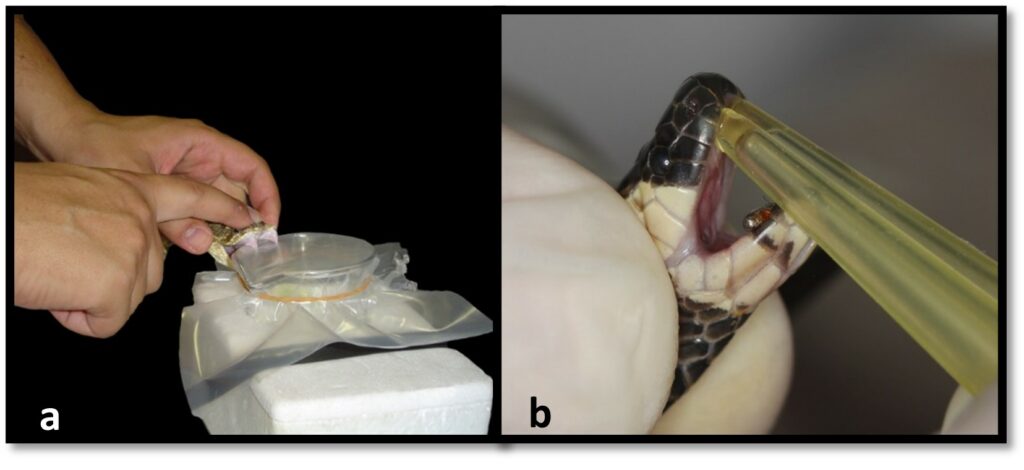Kathleen Fernandes Grego, Scientific researcher VI, Laboratory of Herpetology, Butantan Institute, São Paulo, SP, Brazil.
 The article “Maintenance of venomous snakes in captivity for venom-production at Butantan Institute since 1908 to nowadays: a scoping history” – published in the Journal of Venomous Animals and Toxins including Tropical Diseases (vol. 27) – presents part of the history of this institution that is celebrating its 120th anniversary in February 2021. One of the important missions of the institute is maintaining venomous snakes for the production of antivenom serum to treat persons bitten by Brazilian venomous snakes, whose number reaches 20,000 individuals per year. The article shows that over the years there was a great commitment in offering a better quality of life to the snakes kept in captivity to increase the quality and quantity of venom, as well as the longevity of the animals.
The article “Maintenance of venomous snakes in captivity for venom-production at Butantan Institute since 1908 to nowadays: a scoping history” – published in the Journal of Venomous Animals and Toxins including Tropical Diseases (vol. 27) – presents part of the history of this institution that is celebrating its 120th anniversary in February 2021. One of the important missions of the institute is maintaining venomous snakes for the production of antivenom serum to treat persons bitten by Brazilian venomous snakes, whose number reaches 20,000 individuals per year. The article shows that over the years there was a great commitment in offering a better quality of life to the snakes kept in captivity to increase the quality and quantity of venom, as well as the longevity of the animals.
The use of snake venom to treat snakebites was first discovered by Albert Calmette, a French physician, who believed in a universal serum produced with Naja sp. venom. However, it was the physician Vital Brazil, founder of Butantan Institute, who discovered the specificity of the antivenoms. In other words, he discovered that the person bitten by a venomous snake should be treated with the serum made of the venom of the same species of snake that caused the envenomation. The history presented by the article begins with the successful campaign: “The defense against ophidism”, coordinated by Vital Brazil in the last century, and ends in the present days. From 1908 to 1962, the snakes received from farmers and rural workers were kept in outdoor serpentariums, where their average survival rate was of only 15 days. In 1963 the snakes were transferred to an adapted building to be maintained in an intensive system (inside rooms), where their average survival rate increased to 2 months.

Figure 1. (a) Venom extraction from a rattlesnake performed in a glass Beaker covered with a thick plastic sheet, immersed in ice bath. (b) Venom extraction from a coral snake performed with tips connected to the fangs. Images from the Laboratory of Herpetology, Butantan Institute. Reproduced with permission.
During the severe antivenom serum crisis in 1983, it was utmost to improve snake husbandry to increase venom production. The Brazilian Ministry of Health financed some improvements at the intensive serpentarium, and with this support, snake husbandry could be upgraded, and important hygienic-sanitary management procedures were established to increase the welfare of the animals. Over the years, several enhancements have been made in the intensive serpentarium to guarantee the life quality of the snakes. With the new protocols, the average snake survival increased significantly, being eight years for the genus Bothrops, 10 years for genus Crotalus and Lachesis, and 4 years for the genus Micrurus.
The use of adequate practices in the maintenance of venomous snakes for venom milking, both for antivenom serum production and immunobiological research, is essential for the welfare of snakes in captivity. New techniques and efficient design of husbandry systems must always be sought to improve animal health, to enrich the quality of the venom produced, and the safety of those working directly with the venomous snakes.
References
GREGO, K. F. et al. Anfíbios e serpentes mantidos em instalações de instituições de ensino e pesquisa científica. In: Ministério da Ciência, Tecnologia e Inovação e Conselho Nacional de Controle de Experimentação Animal (organizadores). Guia Brasileiro de Produção, Manutenção ou utilização de animais em atividades de ensino ou pesquisa científica [online]. 2016. pp. 53 – 74 [viewed 24 February 2021]. Available from: https://antigo.mctic.gov.br/mctic/export/sites/institucional/institucional/concea/arquivos/publicacoes/Fasciculo6.pdf
MENDES, G. F. et al. Factors that can influence the survival rates of coral snakes (Micrurus corallinus) for antivenom production. Journal of Animal Science [online]. 2019, vol. 07, no. 02, pp. 972 – 980 [viewed 24 February 2021]. https://doi.org/10.1093/jas/sky467. Available from: https://www.ncbi.nlm.nih.gov/pmc/articles/PMC6358253/
MOTT, M. L. et al. A defesa contra o ofidismo de Vital Brazil e a sua contribuição à Saúde Pública brasileira. Cadernos de História da Ciência [online]. 2011, vol. 07, no. 02, pp. 73 – 85. Available from: http://periodicos.ses.sp.bvs.br/scielo.php?script=sci_arttext&pid=S1809-76342011000200007&lng=pt
WORLD HEALTH ORGANIZATION. Guidelines for the production, control and regulation of snake antivenom immunoglobulins [online]. 2016, pp. 236-246 [viewed 24 February 2021]. Available from: https://www.who.int/bloodproducts/snake_antivenoms/snakeantivenomguide/en/
To read the articles, acess
GREGO, K. F. et al. Maintenance of venomous snakes in captivity for venom production at Butantan Institute from 1908 to the present: a scoping history. J. Venom. Anim. Toxins incl. Trop. Dis [online]. 2021, vol. 27, e20200068 [viewed 24 February 2021]. https://doi.org/10.1590/1678-9199-jvatitd-2020-0068. Available from: http://ref.scielo.org/jdvtwy
External links
Currículo Lattes – Kathleen Fernandes Grego: http://lattes.cnpq.br/4825195763213022
Facebook – Journal of Venomous Animals and Toxins including Tropical Diseases: https://www.facebook.com/JVATiTD
Journal of Venomous Animals and Toxins including Tropical Diseases – JVATITD: http://www.scielo.br/jvatitd
Orcid – Kathleen Fernandes Grego: http://orcid.org/0000-0003-4769-5818
Research Gate – Kathleen Grego: https://www.researchgate.net/profile/Kathleen-Grego/
Site do Instituto Butantan: http://www.butantan.gov.br/
Site Journal of Venomous Animals and Toxins including Tropical Diseases: http://www.jvat.org/
Twitter – Journal of Venomous Animals and Toxins including Tropical Diseases: https://twitter.com/JVATiTD
Como citar este post [ISO 690/2010]:

















Recent Comments